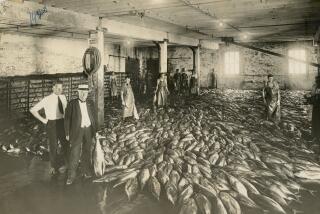Listening for Tales From Those Who Passed Through the Gateway to America
It was 65 years ago, but Louis Vicelja hasn’t forgotten his first day in America.
A 23-day voyage on an overcrowded cargo ship had brought him and a classmate from their native Yugoslavia to Greece, Italy and finally New York Harbor. Now the two 18-year-olds stood in the turreted Great Hall at Ellis Island, waiting in lines that seemed endless.
“Children were crying from hunger and exhaustion,” Vicelja recalled recently. “The sick ones were taken to another building. . . . I don’t know whether they stayed on the island or were sent back to their countries.”
He was lucky.
“I had $20 in my pocket and proof of sponsorship, so I only had to stay on the island about 24 hours.” Before long, he joined an uncle in Arizona and ended up in Los Angeles. Now 82, the retired meat salesman lives in Torrance.
Such stories are just what Gayle Crawford is looking for.
The Manhattan Beach genealogist is trying to find residents of the South Bay and elsewhere in Southern California who came to the United States between 1892 and 1924 by way of Ellis Island. The search is part of a nationwide project aimed at compiling an oral history that will be available at the Ellis Island Museum, expected to open in 1987.
Participants fill out a form indicating name, address, telephone number, age, date and place of birth, native country, arrival date at Ellis Island and the name of the ship they traveled on. From those forms, 200 immigrants nationwide will be selected for taped interviews.
A New York consultant is coordinating the project, which will document the personal experiences and living conditions that made people leave their native countries, as well as traveling conditions, experiences on Ellis Island and migration patterns after leaving New York. The effort is sponsored by the Statue of Liberty-Ellis Island Foundation and the National Parks Service.
Crawford’s task would appear to be an easy one. Eleven million immigrants entered the country during that period, three-fourths of them via Ellis Island, which handled 5,000 to 8,000 a day.
But so far Crawford has received only 75 responses from throughout Southern California, and only 10 from the South Bay--eight in San Pedro and two in Torrance--in spite of notices in several community newspapers.
“We are not asking for money,” she said. “We just want people to come forward and tell their stories. Without adequate response the project cannot be completed.”
Crawford, 46, believes many senior citizens do not read newspapers and hence have not seen the notices she has managed to get published. She has found that several of her respondents learned about the project from neighbors and children.
She also believes that some former immigrants do not want to remember the “old country” because they are now U.S. citizens. In any case, she feels certain there are many more Ellis Island veterans in the South bay, especially in the San Pedro area, which she said was once an immigrant colony.
Indeed, word of the project has not reached everyone. Vicelja, for example, learned of it from a Times reporter who found him with the help of a South Bay nursing home where one of his neighbors works.
A resident of the home, Dena Skrumpis Ballas, is another Ellis Island veteran who was not aware of the project. She arrived in the United States from Greece in 1916, according to her son, Bill Ballas, who recalls hearing her talk about the experience.
She was 20 years old then and had sewn some money into the lining of her coat to make sure she had the minimum $5 required for admission to the United States. An uncle who lived in Los Angeles had sponsored the trip.
She couldn’t speak English, and the language barrier created difficulty while she was being processed on the island, her son said. Shortly after leaving the immigrant center, she boarded a train for Los Angeles.
There, she met and married Peter Ballas, who in 1902 had also come from Greece to the United States by way of Ellis Island. He worked as a bootblack and dishwasher and did construction work on the Southern Pacific Railroad before marrying and settling in Redondo Beach.
Crawford said she intends to contact Vicelja and Mrs. Ballas and hopes to hear from many more South Bay residents. “The project is a way of paying tribute to our ancestors and I hope the South Bay will be represented.”
Those interested can write to Crawford at 1116 8th St., Suite 29, Manhattan Beach, Ca. 90266.
More to Read
Sign up for Essential California
The most important California stories and recommendations in your inbox every morning.
You may occasionally receive promotional content from the Los Angeles Times.










